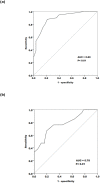Skin Autofluorescence Is Associated with Endothelial Dysfunction in Uremic Subjects on Hemodialysis
- PMID: 26809145
- PMCID: PMC4726548
- DOI: 10.1371/journal.pone.0147771
Skin Autofluorescence Is Associated with Endothelial Dysfunction in Uremic Subjects on Hemodialysis
Abstract
Background: Elevated levels of advanced glycation end products (AGEs) within tissues may contribute to endothelial dysfunction, an early indicator of atherosclerosis. We aimed to investigate whether levels of skin AGEs could be a useful marker to predict endothelial dysfunction in uremic subjects on hemodialysis.
Methods and results: One hundred and nineteen uremic patients on hemodialysis and 57 control subjects with moderate-to-high cardiovascular risk factors and without chronic kidney disease (CKD) were enrolled. We used ultrasound to measure flow-mediated vasodilation (FMD). An AGE reader measured skin autoflurorescence (AF). We then compared differences in FMD and skin AF values between the two groups. The uremic subjects had significantly higher levels of skin AF (3.47±0.76 AU vs. 2.21±0.45 arbitrary units; P<0.01) and significantly lower levels of FMD (4.79%±1.88% vs. 7.19%±2.17%; P<0.01) than the non-CKD subjects. After adjusting for all potential covariates, we found that skin AF level independently predicted FMD in both the hemodialysis and the non-CKD groups. In the hemodialysis group, skin AF ≥ 3.05 arbitrary units predicted abnormal FMD at a sensitivity of 87.9% and a specificity of 78.6% (P<0.01).
Conclusions: Skin AF could be a useful marker to predict endothelial dysfunction in uremic subjects on hemodialysis.
Conflict of interest statement
Figures


Similar articles
-
Association between Subclinical Atherosclerosis Markers and the Level of Accumulated Advanced Glycation End-Products in the Skin of Patients with Diabetes.J Atheroscler Thromb. 2018 Dec 1;25(12):1274-1284. doi: 10.5551/jat.44859. Epub 2018 Jun 30. J Atheroscler Thromb. 2018. PMID: 29962379 Free PMC article.
-
Skin autofluorescence, a measure of cumulative metabolic stress and advanced glycation end products, predicts mortality in hemodialysis patients.J Am Soc Nephrol. 2005 Dec;16(12):3687-93. doi: 10.1681/ASN.2005020144. Epub 2005 Nov 9. J Am Soc Nephrol. 2005. PMID: 16280473
-
Increase in skin autofluorescence and release of heart-type fatty acid binding protein in plasma predicts mortality of hemodialysis patients.Artif Organs. 2013 Jul;37(7):E114-22. doi: 10.1111/aor.12078. Epub 2013 May 2. Artif Organs. 2013. PMID: 23635017
-
Advanced glycation end-products and skin autofluorescence in end-stage renal disease: a review.Clin Chem Lab Med. 2014 Jan 1;52(1):11-20. doi: 10.1515/cclm-2012-0832. Clin Chem Lab Med. 2014. PMID: 23612551 Review.
-
Vascular incompetence in dialysis patients--protein-bound uremic toxins and endothelial dysfunction.Semin Dial. 2011 May-Jun;24(3):327-37. doi: 10.1111/j.1525-139X.2011.00925.x. Semin Dial. 2011. PMID: 21682773 Review.
Cited by
-
Skin autofluorescence is associated with rapid renal function decline in subjects at increased risk of coronary artery disease.PLoS One. 2019 May 22;14(5):e0217203. doi: 10.1371/journal.pone.0217203. eCollection 2019. PLoS One. 2019. PMID: 31116778 Free PMC article.
-
Electronegative low-density lipoprotein increases the risk of ischemic lower-extremity peripheral artery disease in uremia patients on maintenance hemodialysis.Sci Rep. 2017 Jul 5;7(1):4654. doi: 10.1038/s41598-017-04063-3. Sci Rep. 2017. PMID: 28680087 Free PMC article.
-
Spironolactone ameliorates endothelial dysfunction through inhibition of the AGE/RAGE axis in a chronic renal failure rat model.BMC Nephrol. 2019 Sep 6;20(1):351. doi: 10.1186/s12882-019-1534-4. BMC Nephrol. 2019. PMID: 31492107 Free PMC article.
-
Relationships Between Skin Autofluorescence and Cardio-Ankle Vascular Index in Japanese Male Patients With Metabolic Syndrome.Cardiol Res. 2019 Jun;10(3):172-180. doi: 10.14740/cr878. Epub 2019 Jun 7. Cardiol Res. 2019. PMID: 31236180 Free PMC article.
-
Toxin Removal and Inflammatory State Modulation during Online Hemodiafiltration Using Two Different Dialyzers (TRIAD2 Study).Methods Protoc. 2021 Apr 22;4(2):26. doi: 10.3390/mps4020026. Methods Protoc. 2021. PMID: 33921921 Free PMC article.
References
-
- Shafi T, Meyer TW, Hostetter TH, Melamed ML, Parekh RS, Hwang S, et al. Free levels of selected organic solutes and cardiovascular morbidity and mortality in hemodialysis patients: Results from retained organic solutes and clinical outcomes (ROSCO) investigators. PLoS One 2015; 10(5): e0126048 10.1371/journal.pone.0126048 - DOI - PMC - PubMed
-
- U.S. Renal Data system, USRDS 2013 Annual Data Report: Atlas of chronic kidney disease and end stage renal disease in the United States, National Institute of Health, National Institute of Diabetes and Digestive and Kidney Diseases, Bethesda, Maryland. 2015; 4: 2.
-
- Parfrey PS, Foley RN. The clinical epidemiology of cardiac disease in chronic renal failure. J Am Soc Nephrol 1999; 10: 1606–1615. - PubMed
-
- Foley RN, Murray AM, Li S, Herzog CA, McBean AM, Eggers PW, et al. Chronic kidney disease and the risk for cardiovascular disease, renal replacement, and death in the united states medicare population, 1998–1999. J Am Soc Nephrol 2005; 16: 489–495. - PubMed
-
- Himmelfarb J, Stenvinkel P, Ikizler TA, Hakim RM. The elephant in uremia: oxidant stress as a unifying concept of cardiovascular disease in uremia. Kidney Int 2002; 62: 1524–1538. - PubMed
Publication types
MeSH terms
Substances
LinkOut - more resources
Full Text Sources
Other Literature Sources
Medical

